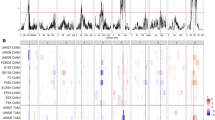Abstract
A new methodology based on mixed linear models was developed for mapping QTLs with digenic epistasis and QTL×environment (QE) interactions. Reliable estimates of QTL main effects (additive and epistasis effects) can be obtained by the maximum-likelihood estimation method, while QE interaction effects (additive×environment interaction and epistasis×environment interaction) can be predicted by the-best-linear-unbiased-prediction (BLUP) method. Likelihood ratio and t statistics were combined for testing hypotheses about QTL effects and QE interactions. Monte Carlo simulations were conducted for evaluating the unbiasedness, accuracy, and power for parameter estimation in QTL mapping. The results indicated that the mixed-model approaches could provide unbiased estimates for both positions and effects of QTLs, as well as unbiased predicted values for QE interactions. Additionally, the mixed-model approaches also showed high accuracy and power in mapping QTLs with epistatic effects and QE interactions. Based on the models and the methodology, a computer software program (QTLMapper version 1.0) was developed, which is suitable for interval mapping of QTLs with additive, additive×additive epistasis, and their environment interactions.
Similar content being viewed by others
Author information
Authors and Affiliations
Additional information
Received: 23 October 1998 / Accepted: 11 May 1999
Rights and permissions
About this article
Cite this article
Wang, D., Zhu, J., Li, Z. et al. Mapping QTLs with epistatic effects and QTL×environment interactions by mixed linear model approaches. Theor Appl Genet 99, 1255–1264 (1999). https://doi.org/10.1007/s001220051331
Issue Date:
DOI: https://doi.org/10.1007/s001220051331




